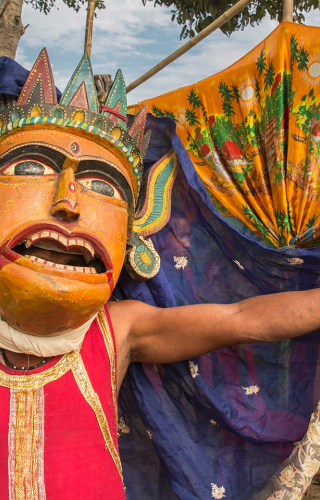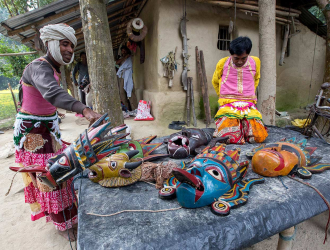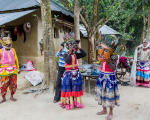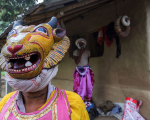Masks have always intrigued me and I collect them wherever I visit. Masks come in a variety of motifs, shapes, sizes, colours and materials, typical of the place they originate from. Each mask represents a particular character which forms part of a larger narrative, often rooted in local folklore, religious literature and mythology.
I got an opportunity to learn more about masks during a visit to Kushmandi village, in North Dinajpur district, in West Bengal. The night train from Kolkata took me to Raiganj, the district headquarters, from where Kushmandi is an hour’s drive. Kushmandi is home to 200 craftsmen who make the wooden masks worn during gomira dances. I was accompanied by Saurav Roy, a local schoolteacher and social worker who has been involved with the gomira mask makers for many years. He took me along to witness a gomira dance performance in the village. The venue for the Gomira dance is an open arena, known as Gomirar Tola, which is usually located next to a shrine, called thaan. The thaan is dedicated to Shakti deities and located below a banyan tree, a little distance from the village. Gomira dance has its roots in the cult of Shakti (mother goddess) and the word gomira is believed to derive from Gram-Chandi (a local Shakti deity), alternatively it could be derived from the gamar wood used to make the masks. In North Dinajpur district, each village has a temple dedicated to Shakti whose different forms are worshipped as guardian deities. The night before the dance, the masks are brought out and placed for Nishi Puja, conducted at midnight. Next day, the dance takes place at Gomirar Tola to the beating of dhaks (drum) and kansa (percussion instruments), without any background songs, narration or chants. The dances are usually organised between mid-April to mid-June, coinciding with the sowing season, though there are no fixed dates. Each village has its own Gomira dance troupe and they organise at least one dance performance during this period. There are two distinct dance forms—one is gomira, which has masks depicting Chamunda, Samshan Kali, Siknidhal, Masan Kali, Bagh, Dakini Bishwal, Nara-Rakshas and a host of other characters. The dance commences with the entry of two characters, Buro-Buri, who are representations of Shiva and Parvati. The other dance form is Ram-Vanvas, based on the story of Rama’s exile to the forest from the Ramayana. The characters in this dance include Rama, Sita, Angad, Jatayu, Hanuman, Sugriv, Kaikeyi, Kaushalya, Dasharath and Ravana.
Though it is referred to as a dance, the performance is not codified through specific bodily movements or gestures. The movements are spontaneous, instinctive and improvised by the dancers who often go into a state of trance during the performance, which is called bhor. It is believed that while experiencing bhor, the dancer becomes possessed by the characteristics of the deity whose mask he is wearing. Saurav, my companion, explained that villagers pledge (manat) a certain type and number of masks to their favoured deity on the fulfilment of a wish. That is how the tradition of mask making began.
Over the years, the gomira mask has gained recognition and emerged as a small-scale cottage industry. We went to meet Samarendra Sarkar, a master craftsman, now in his 70s. He has been making masks for more than half a century, having learnt the trade from his father. According to Samarendra, the family has been making masks for more than six generations. During our conversations, he explained the process of making the masks, they are traditionally carved from neem wood, but nowadays cheaper wood such as mango, pakur, kadam, gamhar are used to reduce the cost. For the ease of use, papier-mâché masks are also made, but they are less durable. Of late, craftsmen have also started making new products out of sculpted bamboo.
The three-day stay in Kushmandi was an eye-opener for me. It made me realise how traditional values,culture, and history influence the process of mask making. This is probably true of all the masks that adorn my wall in my room: they are not just decorative elements; like each of us, they also have a distinct personality. Today I look at them with new eyes, hoping to unravel their individual mysteries one day.

















